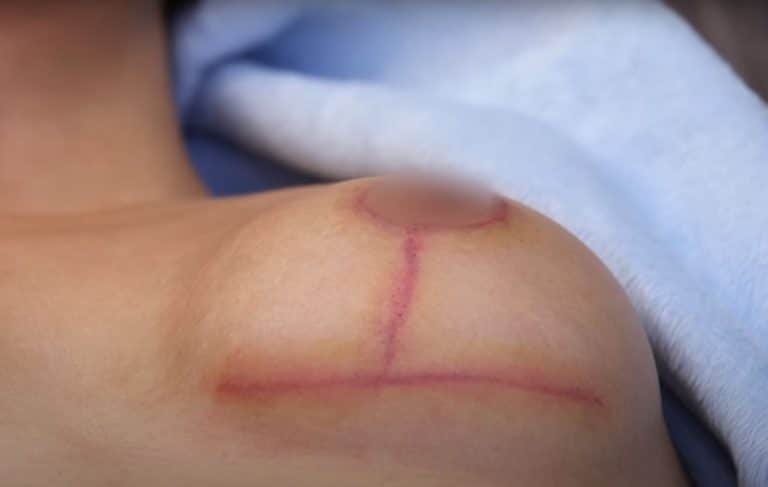Scar Solutions: A Comprehensive Look at Breast Reduction Scarring
Breast reduction surgery, a procedure aimed at alleviating physical discomfort and enhancing body image, has emerged as a pivotal solution for many. This surgical intervention not only addresses aesthetic concerns but also tackles health-related issues such as back pain and posture problems. By removing excess breast tissue, fat, and skin, patients often experience significant improvements in their quality of life. The decision to undergo breast reduction is multifaceted, involving considerations of physical well-being, psychological benefits, and the potential impact on lifestyle. As we delve into the intricacies of this procedure, it’s crucial to understand its implications fully.
Breast Reduction Scars Overview
Natural Outcome
Scars are inevitable after a breast reduction surgery. Every person’s body heals differently. This means the appearance of scars varies widely.
The size and visibility of scars depend on several factors. These include the surgical technique used, your body’s healing ability, and how well you follow post-operative care instructions. For many, scars become less noticeable over time.
Healing Process
Early care is key for good healing. After a breast reduction procedure, it’s important to follow all your surgeon’s advice closely.
Here are some tips for optimal healing:
- Keep the surgical area clean.
- Avoid strenuous activities that might strain your chest.
- Use scar treatment creams if recommended by your doctor.
These steps can help minimize scarring and promote faster healing.
Breast reduction can significantly improve quality of life for people with large breasts. It can reduce back pain, improve posture, and increase comfort in daily activities. Despite the potential for scarring, many find these benefits outweigh the drawbacks.
Types of Breast Reduction Scars
Anchor Scars
Anchor scars are named for their shape. They resemble the outline of an anchor. This type is common in traditional breast reduction surgeries.
The scar starts around the areola. It goes vertically down and then horizontally along the breast crease. The surgeon removes excess skin and tissue through this pattern.
Lollipop Scars
Lollipop scars get their name from their circular and straight-line pattern. They look like a lollipop. This scar type is less extensive than anchor scars.
It circles the areola and extends down to the breast crease only. Lollipop scars result from a technique that involves less tissue removal.
Both types of scars depend on surgical techniques used by surgeons. Each has its distinct location and pattern on the body.
- Anchor scars offer more dramatic results but come with longer scar lines.
- Lollipop scars provide significant lifting with minimized scarring compared to anchor types.
Choosing between these depends on individual needs, desired outcomes, and professional advice from a surgeon.
Healing Timeline for Breast Reduction Scars
Initial Phase
The initial healing phase for breast reduction scars is crucial. It can last up to two weeks. During this time, patients may notice redness and swelling around the scar areas. Proper care is essential.
It’s important to follow your surgeon’s advice closely during this period. Keeping the wound clean and avoiding strenuous activities helps in faster recovery.
Significant Improvement
Within the first 3 to 6 months, a significant improvement in scar appearance is observed. The scars start to fade gradually, becoming less noticeable.
Patients should continue with proper scar care routines suggested by their healthcare provider. This includes using silicone sheets or gel which has been shown to improve the appearance of scars over time.
Full Maturation
The full maturation of breast reduction scars may take up to a year or more. However, patience pays off as these scars become much less visible.
During this stage, it’s vital to protect the scars from sun exposure by applying sunscreen regularly. Sunlight can darken the scars making them more prominent.
- To summarize:
- The initial healing phase lasts up two weeks.
- Significant improvement happens within 3-6 months.
- Full maturation takes a year or more.
Following these stages ensures that your journey towards recovering from breast reduction surgery is smooth and effective. Remembering that each individual heals at their own pace is key; comparing one’s progress with others might not be helpful.
Location and Visibility of Breast Reduction Scars
Scar Placement
Breast reduction surgery leaves scars. They are often around the nipple, vertically down, and under the breast fold. This pattern is common.
Surgeons carefully place scars to be less noticeable. The scar around the nipple blends with the color change at the edge of the areola. It becomes harder to see over time.
Clothing Choices
Clothing and swimsuits can hide scars well. Most outfits cover them completely.
Choosing specific styles helps keep scars out of sight. For example, high-waisted bottoms or one-piece swimsuits work great for swimming.
Scar visibility varies greatly among individuals. Factors include skin type, healing speed, and surgical skill. Strategic surgical techniques aim to minimize how visible these scars are. Doctors plan incisions based on each patient’s body shape and goals.
Managing Breast Reduction Scars
Post-Surgery Care
After breast reduction surgery, immediate care is crucial. Keeping incisions clean and dry helps prevent infection. This step is the first in managing breast reduction scars effectively.
Patients should follow their plastic surgeon’s advice closely. Instructions usually include how to clean the area and what signs of complications to watch for.
Silicone Treatments
Once wounds have closed, using silicone sheets or gels can be beneficial. These products are recommended by many plastic surgeons because they help flatten and soften scars.
Silicone treatments create a protective barrier over the scar. This barrier retains moisture, which aids in healing. Studies show that consistent use can improve scar appearance significantly.
Sun Protection
Protecting scars from the sun is essential to prevent them from darkening. UV exposure can make breast reduction scars more noticeable.
Wearing a high SPF sunscreen on scar areas when outdoors is vital. Also, covering up with clothing or a supportive bra offers additional protection against UV rays.
Minimizing Scar Appearance
Scar Care
After a breast reduction, caring for surgical incisions is crucial. Consistent use of scar treatment products can make a big difference. Products like silicone gels or sheets are popular choices. They help in keeping the area hydrated, which may reduce the visibility of scars.
Applying sunscreen to the scars when exposed to sunlight is also important. This prevents darkening, especially on natural skin tone or dark skin. Sunscreen should become a regular part of your skincare routine post-surgery.
Professional Options
For those seeking more advanced options, professional treatments offer additional benefits. Laser therapy stands out as an effective method for improving scar appearance after breast reduction surgery.
Laser treatments work by targeting and breaking down scar tissue, promoting healthier skin regeneration. This process can significantly enhance both the texture and coloration of scars, making them blend more seamlessly with your natural skin tone.
Massage therapy is another technique recommended by surgeons for its dual benefits: it not only improves the flexibility but also the texture of scar tissue over time.

Effectiveness of Scar Treatments
Silicone-Based Solutions
Silicone-based products have a strong reputation. Numerous studies back their effectiveness in scar management, especially after breast reduction surgery. These products work by creating a protective barrier over the scar. This helps maintain hydration and allows the skin to heal more effectively.
However, it’s crucial to note that results can vary significantly from person to person. Factors such as skin type, scar size, and individual healing processes play a role. For some, silicone-based treatments are a game-changer; for others, the improvements might be less noticeable.
Early Intervention
Starting treatment early often leads to better outcomes. The sooner you begin using scar treatment products after your breast reduction surgery, the more effective they tend to be. This doesn’t mean late starters won’t see improvements but starting early can give you a head start on minimizing scarring.
It’s also important to manage expectations. While many individuals see great results with silicone-based products or other treatments:
- Not all scars will fade completely.
- Patience is key as most treatments take time to show results.
- Consistency in application plays a critical role in effectiveness.
Potential Changes in Breast Reduction Scars Over Time
Scar Fading
Breast reduction scars typically fade over time. Initially, they may appear red and prominent. However, with proper care, these scars often become less noticeable within a year or two.
The fading process varies from person to person. Some might see their scars lighten significantly, blending into the skin’s natural tone. Others may notice slower changes. Factors like skin type and genetics play crucial roles.
Thickening Risks
Unfortunately, not all breast reduction scars improve with time without issues. Some individuals experience thickened or raised scars known as keloids or hypertrophic scarring.
This condition can be more common in certain skin types and might require additional treatments such as steroid injections or laser therapy to reduce scar prominence.
External Factors
External factors can influence how breast reduction scars heal and change over years. These include:
- Hormonal changes: They can affect skin elasticity and scar appearance.
- Weight fluctuations: Significant weight gain or loss can stretch the skin around the scar area, potentially altering its appearance.
- Aging: As the skin naturally ages, it loses collagen and elasticity which could lead to sagging around the surgery site affecting how visible the scars are.
It’s important for patients to understand that while most breast reduction scars improve over time, there is a risk of them becoming more pronounced due to various external factors.
Closing Thoughts
Breast reduction surgery, while offering significant physical and psychological benefits, also brings concerns about scarring. The journey from understanding the different types of breast reduction scars to exploring the effectiveness of various scar treatments is crucial for individuals considering this procedure. They must recognize that scars are a natural part of the healing process, with their visibility and appearance changing over time. Proper care and management strategies can significantly minimize their impact, enhancing the overall outcome of the surgery.
Individuals should engage in detailed discussions with their healthcare providers about expectations, scar management techniques, and the long-term care of surgical scars. This proactive approach ensures they are well-informed and prepared for the post-operative journey. For those seeking further information or support regarding breast reduction and scar management, consulting a certified medical professional is highly recommended.
Frequently Asked Questions
What are the different types of breast reduction scars?
Breast reduction typically results in one of three scar types: a circular pattern around the areola, a keyhole shape running around the areola and down to the breast crease, or an anchor shape that includes a horizontal scar along the breast fold.
How long does it take for breast reduction scars to heal?
Initial healing of surgical wounds takes about 2-3 weeks. However, scars mature and fade over time, with significant improvements seen within 1-2 years post-surgery.
Where will my scars be located after a breast reduction?
Scars from breast reduction surgery are usually located around the areola, vertically down from the areola to the under-breast fold, and possibly along the crease beneath your breast depending on your specific procedure.
Can I do anything to manage my breast reduction scars better?
Yes. Proper wound care post-surgery, applying silicone sheets or gel once healed, using sunscreen on exposed scars, and following surgeon’s recommendations diligently can significantly improve scar appearance over time.
Are there effective treatments for minimizing the appearance of breast reduction scars?
Yes. Treatments such as silicone sheeting or gels have been shown effective in making scars less noticeable. Laser therapy and microneedling can also improve skin texture and reduce scar visibility but should be discussed with a dermatologist or plastic surgeon.
Do breast reduction scars change over time?
Yes. Breast reduction scars typically become less prominent over time. They may start off red and raised but generally fade to thin white lines within 1-2 years if properly cared for during recovery.




